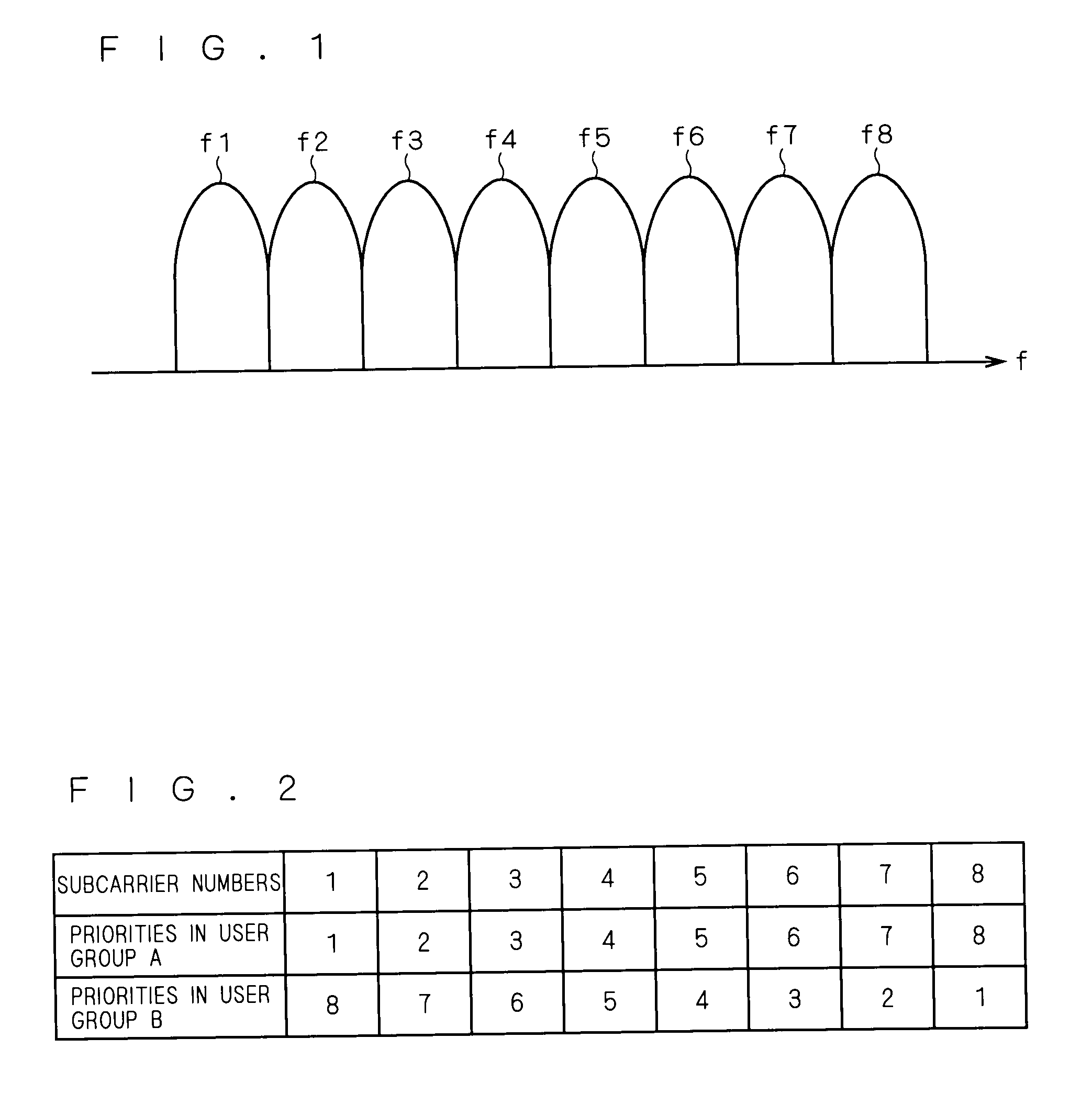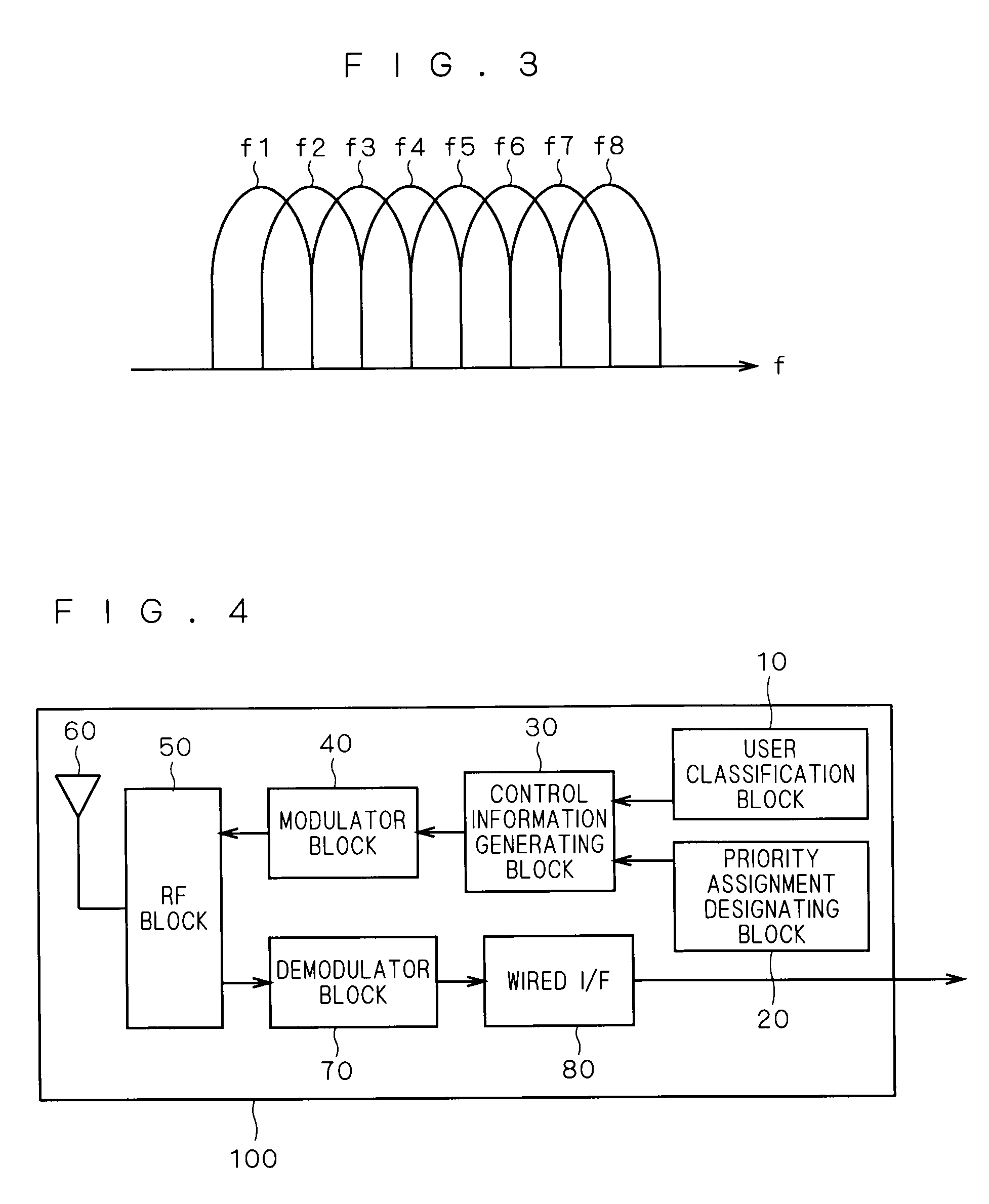Wireless Communication System and Wireless Communication Method
a wireless communication and wireless communication technology, applied in wireless communication, transmission path sub-channel allocation, transmission path division, etc., can solve the problems of complicated device configuration and complicated device configuration, and achieve the effect of reducing the rate of contention channel collisions
- Summary
- Abstract
- Description
- Claims
- Application Information
AI Technical Summary
Benefits of technology
Problems solved by technology
Method used
Image
Examples
first preferred embodiment
[0048]FIGS. 1 and 2 are schematic diagrams illustrating the operation of a radio communications system (a radio communications method) according to a first preferred embodiment. FIG. 1 shows an example in which subcarriers f1 to f8 are frequency bands of the FDM. The subcarriers f1 to f8 are assigned by a single base station to a plurality of mobile stations that are subordinate to the base station. In this specification, it is assumed that the subcarriers fn (n: an integer) have unique subcarrier numbers “n”, and that the subcarrier numbers are assigned in ascending order from the lowest frequency to the highest frequency in the frequency domain.
[0049]In FIG. 2, a plurality of mobile stations are classified into two kinds of user groups A and B, and the user groups A and B are respectively assigned the priorities of the subcarriers f1 to f8. The user groups A and B are classified on the basis of information like user IDs unique to the mobile stations, their telephone numbers, etc. ...
second preferred embodiment
[0083]In general, the subcarriers in a multi-carrier scheme (FDM or OFDM) have a transmission path characteristic that depends on frequency. The transmission path characteristic may therefore be considered when assigning the subcarriers as radio resources.
[0084]FIG. 11 is a diagram illustrating the assignment of subcarriers in a radio communications system according to a second preferred embodiment. In FIG. 11, the bands 310 and 330 have high communication quality (receiving sensitivity), and the band 320 has low communication quality. In this case, the quality of communications can be enhanced by preferentially using the bands 310 and 330 as radio resources, than using the band 320 (by assigning the series of subcarriers 340 and the series of subcarriers 350). In this specification, an arrangement of a plurality of subcarriers at equal intervals in the frequency domain is referred to (simply) as a series of subcarriers.
[0085]The transmission path characteristic can be estimated, in...
third preferred embodiment
[0107]The subcarriers used as radio resources may be designated by their subcarrier numbers that are allocated to a plurality of subcarriers arranged at equal intervals in the frequency domain (a series of subcarriers) in ascending order from the lowest frequency to the highest frequency, or they can be designated by subcarrier allocation information including given parameters, etc.
[0108]FIG. 16 is a block diagram illustrating the functions of a base station 100c in a radio communications system according to a third preferred embodiment. As compared with FIG. 4, the configuration of FIG. 16 includes a subcarrier allocation information storing block 93 that inputs the subcarrier allocation information to the modulation block 40 (some parts are not shown for the sake of convenience). The subcarrier allocation information storing block 93 stores subcarrier allocation information that contains given parameters etc. for designating the subcarriers used as radio resources. The subcarrier ...
PUM
 Login to View More
Login to View More Abstract
Description
Claims
Application Information
 Login to View More
Login to View More - R&D
- Intellectual Property
- Life Sciences
- Materials
- Tech Scout
- Unparalleled Data Quality
- Higher Quality Content
- 60% Fewer Hallucinations
Browse by: Latest US Patents, China's latest patents, Technical Efficacy Thesaurus, Application Domain, Technology Topic, Popular Technical Reports.
© 2025 PatSnap. All rights reserved.Legal|Privacy policy|Modern Slavery Act Transparency Statement|Sitemap|About US| Contact US: help@patsnap.com



